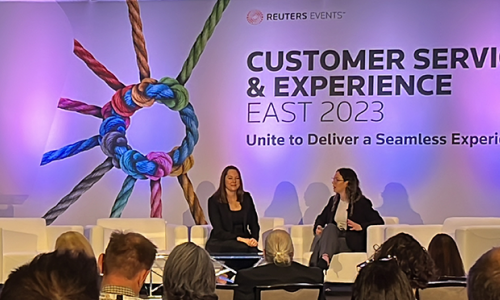What makes a leader effective at driving change within an organization? Research from TeleTech Consulting reveals that when it comes to leadership, conventional wisdom isn’t always the most effective. Over the past two years, we surveyed more than 5,000 business users about their organization’s leadership effectiveness. We found that leaders who focused on emotional drivers tended to be the most effective.
Respondents were asked about their leadership activities. We then mapped those to a framework of 12 leadership drivers we call Vision to Results (VTR) to see what stood out (see Figure 1).
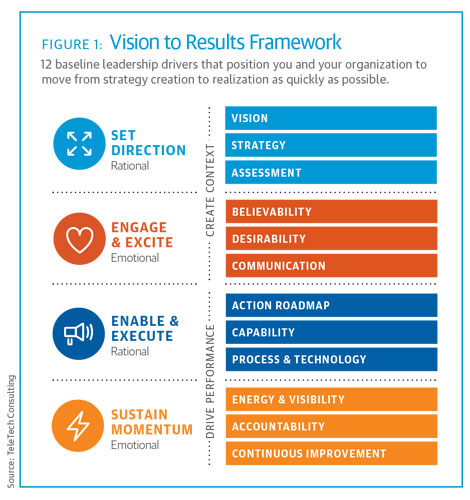
There are four stages in the VTR framework. Two are “rational” (Set Direction and Enable & Execute). Two are “emotional” (Engage & Excite and Sustain Momentum). Six of the drivers lie in the “Create Context” section, and are about setting the goal and engaging the people and resources to make it happen. They feed into the six drivers in the “Drive Performance” section, which concern getting the vision done and producing results. The Rational drivers are targets that can be achieved and completed. The Emotional drivers require constant attention and reinforcement.
The research uncovered common strengths and weaknesses facing many leaders (see Figure 2). We also discovered the most effective leaders excel in the emotional driver of believability, rather than the more rational accountability.*
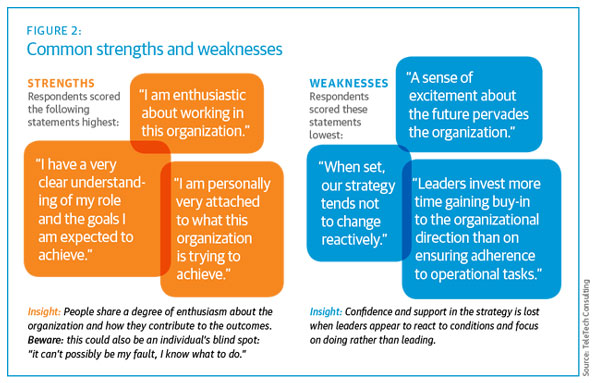
We also asked people to allocate units of time to the activities that they want leaders to focus their energy on. Two stood out as most important to employees:
- Clearly communicating the strategy (plans) for achieving the vision, so that everyone is clear on the key initiatives to get there.”
- Revisiting the vision and strategy to ensure they reflect the reality of our external and internal environments.”
Insight: These point to poor performance by leaders in the “communication” domain, and reinforces the finding that leaders aren’t able to build belief and excitement in the vision and strategy as conditions change.
The most successful leaders engage and inspire trust among employees
Across all our data, respondents chose Enable & Execute as the strongest VTR area within their organization (see Figure 3). This isn’t surprising, as conventional wisdom says that leaders tend to prioritize tangible elements. Next is Engage & Excite, Set Direction, and lastly Sustain Momentum.
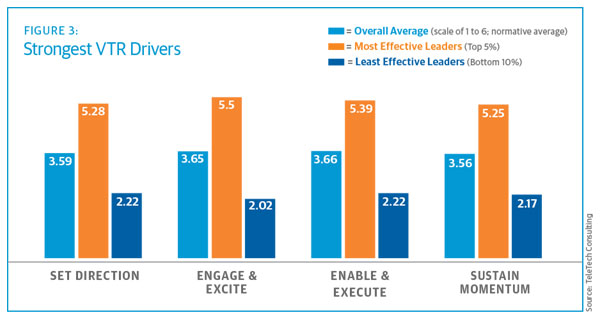
However, a different picture emerges when you slice the results into leaders and laggards. Engage & Excite is the strongest element for leaders ranked in the top 5 percent in terms of effectiveness, followed by nable & Execute, Set Direction, and Sustain Momentum. Meanwhile, Engage & Excite is the lowest scoring VTR area for those at the bottom 10 percent of results, or the least effective leaders. They ranked Execute and Set Direction (tie) as their strongest elements.
Insight: Effective leadership is driven by how successful the leadership team can engage and excite their team and how effectively they can execute their plans.
Accountability is the strongest performing driver in the overall results, while Capability is the weakest (see Figure 4). However, Believability is by far the strongest driver for the most effective leaders, followed by a tie for Desirability, Prioritized Activity, Capability, and Accountability. At the bottom 10 percent we see little difference among the drivers, with Reality and Accountability featuring as the top scorers.
Insight: Top performing leaders really get the “buy in” working, demonstrate the required capabilities, and are more driven in terms of execution than the rest.
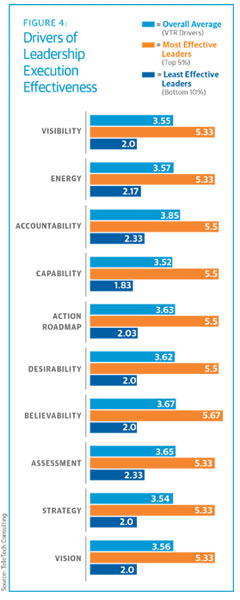
The most effective leaders are ones who can engage and excite their teams, and who instill believability that the strategy is the right direction. They know that authentic leadership comes from staying true to the vision in the face of adversity and change. They are therefore not too reactive, which provides others with the confidence to follow them. If a change in strategy is necessary to respond to a changing marketplace, then the most successful leaders promote transparent conversations to help people see how the new tactics will enable the organization to hold its course so it can deliver on the results aligned with the vision.
The data suggests that average leaders, on the other hand, drive accountability above all the other drivers. That implies using the age-old behavior modifying techniques of the ‘stick.’ It leads to an unhealthy corporate environment that drives compliance, which in turn delivers low morale and a lack of innovation. This approach is gravely ineffective if the team does not believe or desire the leader’s vision.
Individually, the elements are important. But, it’s the combination of all four that creates true customer-centric leadership. And each driver impacts the next. For example, if your team isn’t engaged and excited about the customer-centric direction you’re championing, find out whether the broader team is connected to the purpose and understands the strategy. Clarifying the direction will help. And if the organization is truly engaged and excited but execution is still failing, the question to ask is whether leaders are executing their prioritized leadership tasks in cascading the customer-centric direction consistently and effectively.
Conclusion
Leadership can sometimes appear complicated and feel personal. In those instances, it is sometimes best to fall back on a tried and tested framework to help objectively assess what drivers will lift performance. In every case, the data shows that developing the emotional driver of believability, ahead of driving accountability, will deliver better results.





